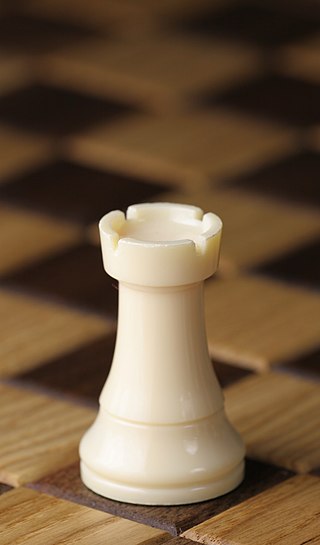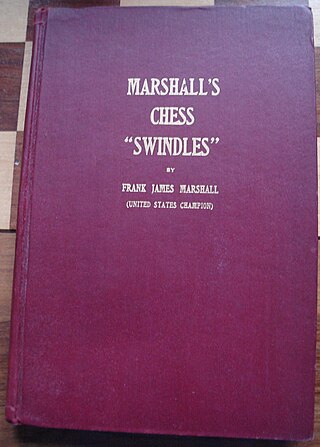Chess strategy is the aspect of chess play concerned with evaluation of chess positions and setting goals and long-term plans for future play. While evaluating a position strategically, a player must take into account such factors as the relative value of the pieces on the board, pawn structure, king safety, position of pieces, and control of key squares and groups of squares. Chess strategy is distinguished from chess tactics, which is the aspect of play concerned with the move-by-move setting up of threats and defenses. Some authors distinguish static strategic imbalances, which tend to persist for many moves, from dynamic imbalances, which are temporary. This distinction affects the immediacy with which a sought-after plan should take effect. Until players reach the skill level of "master", chess tactics tend to ultimately decide the outcomes of games more often than strategy. Many chess coaches thus emphasize the study of tactics as the most efficient way to improve one's results in serious chess play.

The rook is a piece in the game of chess. It may move any number of squares horizontally or vertically without jumping, and it may capture an enemy piece on its path; additionally, it may participate in castling. Each player starts the game with two rooks, one in each corner on their own side of the board.
The endgame is the final stage of a chess game which occurs after the middlegame. It begins when few pieces are left on the board.
Stalemate is a situation in chess where the player whose turn it is to move is not in check and has no legal move. Stalemate results in a draw. During the endgame, stalemate is a resource that can enable the player with the inferior position to draw the game rather than lose. In more complex positions, stalemate is much rarer, usually taking the form of a swindle that succeeds only if the superior side is inattentive. Stalemate is also a common theme in endgame studies and other chess problems.
The King's Gambit is a chess opening that begins with the moves:

The World Chess Championship 1972 was a match for the World Chess Championship between challenger Bobby Fischer of the United States and defending champion Boris Spassky of the Soviet Union. The match took place in the Laugardalshöll arena in Reykjavík, Iceland, and has been dubbed the Match of the Century. Fischer became the first American born in the United States to win the world title, and the second American overall. Fischer's win also ended, for a short time, 24 years of Soviet domination of the World Championship.
In chess, a relative value is a standard value conventionally assigned to each piece. Piece valuations have no role in the rules of chess but are useful as an aid to assessing a position.
Triangulation is a tactic used in chess to put one's opponent in zugzwang. Triangulation is also called losing a tempo or losing a move.
In chess, a passed pawn is a pawn with no opposing pawns to prevent it from advancing to the eighth rank; i.e. there are no opposing pawns in front of it on either the same file or adjacent files. A passed pawn is sometimes colloquially called a passer. Passed pawns are advantageous because only the opponent's pieces can stop them from promoting.
In chess, a sacrifice is a move that gives up a piece with the objective of gaining tactical or positional compensation in other forms. A sacrifice could also be a deliberate exchange of a chess piece of higher value for an opponent's piece of lower value.
The chess endgame with a king and a pawn versus a king is one of the most important and fundamental endgames, other than the basic checkmates. It is an important endgame for chess players to master, since most other endgames have the potential of reducing to this type of endgame via exchanges of pieces. Players need to be able to determine quickly whether a given position is a win or a draw, and to know the technique for playing it. The crux of this endgame is whether or not the pawn can be promoted, so checkmate can be forced.
In chess, the exchange is the material difference of a rook for a minor piece. Having a rook for a minor piece is generally advantageous, since the rook is usually more valuable. A player who has a rook for a minor piece is said to be up the exchange, and the other player is down the exchange. A player who wins a rook for a minor piece is said to have won the exchange, while the other player has lost the exchange. The opposing captures often happen on consecutive moves, but this is not strictly necessary. Although it is generally detrimental to lose the exchange, one may occasionally find reason to purposely do so; the result is an exchange sacrifice.
In chess, a fortress is an endgame drawing technique in which the side behind in material sets up a zone of protection that the opponent cannot penetrate. This might involve keeping the enemy king out of one's position, or a zone the enemy cannot force one out of. An elementary fortress is a theoretically drawn position with reduced material in which a passive defense will maintain the draw.
The rook and pawn versus rook endgame is a fundamentally important, widely studied chess endgame. Precise play is usually required in these positions. With optimal play, some complicated wins require sixty moves to either checkmate, capture the defending rook, or successfully promote the pawn. In some cases, thirty-five moves are required to advance the pawn once.

In chess, a swindle is a ruse by which a player in a losing position tricks their opponent and thereby achieves a win or draw instead of the expected loss. It may also refer more generally to obtaining a win or draw from a clearly losing position. I. A. Horowitz and Fred Reinfeld distinguish among "traps", "pitfalls", and "swindles". In their terminology, a "trap" refers to a situation where players go wrong through their own efforts. In a "pitfall", the beneficiary of the pitfall plays an active role, creating a situation where a plausible move by the opponent will turn out badly. A "swindle" is a pitfall adopted by a player who has a clearly lost game. Horowitz and Reinfeld observe that swindles, "though ignored in virtually all chess books", "play an enormously important role in over-the-board chess, and decide the fate of countless games".
The opposite-colored bishops endgame is a chess endgame in which each side has a single bishop and those bishops operate on opposite-colored squares. Without other pieces besides pawns and the kings, these endings are widely known for their tendency to result in a draw. These are the most difficult endings in which to convert a small material advantage to a win. With additional pieces, the stronger side has more chances to win, but still not as many as when bishops are on the same color.
A pawnless chess endgame is a chess endgame in which only a few pieces remain, and no pawns. The basic checkmates are types of pawnless endgames. Endgames without pawns do not occur very often in practice except for the basic checkmates of king and queen versus king, king and rook versus king, and queen versus rook. Other cases that occur occasionally are (1) a rook and minor piece versus a rook and (2) a rook versus a minor piece, especially if the minor piece is a bishop.
In a chess endgame of a king, bishop, and pawn versus king, a wrong rook pawn is a rook pawn whose promotion square is the opposite color from the bishop's square color. Since a side's rook pawns promote on opposite-colored squares, one of them may be the "wrong rook pawn". This situation is also known as having the wrong-colored bishop or wrong bishop. In many cases, the wrong rook pawn will only draw, when any other pawn would win. This is because the defending side can sometimes get their king to the corner in front of the pawn, after which the attacking side cannot chase the king away to enable promotion. A fairly common defensive tactic is to reach one of these drawn endgames, often through a sacrifice.
The queen and pawn versus queen endgame is a chess endgame in which both sides have a queen and one side has a pawn, which one tries to promote. It is very complicated and difficult to play. Cross-checks are often used as a device to win the game by forcing the exchange of queens. It is almost always a draw if the defending king is in front of the pawn.




